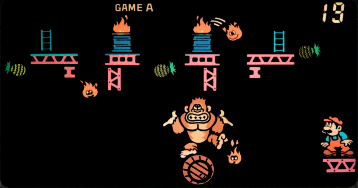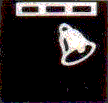Donkey Kong Circus: Difference between revisions
m (Text replacement - "<references/> {{" to "<references/> {{") |
mNo edit summary Tag: Mobile edit |
||
| Line 13: | Line 13: | ||
}} | }} | ||
__NOTOC__ | __NOTOC__ | ||
'''''Donkey Kong Circus''''' is a [[Game & Watch]] title released as part of the Panorama series on September 6, 1984.<ref name="ITA">[http://www.intheattic.co.uk/donkey_kong_circus.htm ''Donkey Kong Circus'' info page on In The Attic, a website dedicated to classic videogames] Retrieved 13 November 2010</ref> It is a remake of the second [http://www.intheattic.co.uk/mickey_mouse1.htm ''Mickey Mouse''] Game & Watch game, which was released worldwide seven months earlier. The two games' codes even seem to have gotten mixed up, with ''Mickey Mouse'' being model "DC-95" and ''Donkey Kong Circus'' being "MK-96."<ref name="ITA"/> Neither the Panorama Screen ''Mickey Mouse'' nor ''Donkey Kong Circus'' was released in Japan. | '''''Donkey Kong Circus''''' is a [[Game & Watch]] title released as part of the Panorama Screen series on September 6, 1984.<ref name="ITA">[http://www.intheattic.co.uk/donkey_kong_circus.htm ''Donkey Kong Circus'' info page on In The Attic, a website dedicated to classic videogames] Retrieved 13 November 2010</ref> It is a remake of the second [http://www.intheattic.co.uk/mickey_mouse1.htm ''Mickey Mouse''] Game & Watch game, which was released worldwide seven months earlier. The two games' codes even seem to have gotten mixed up, with ''Mickey Mouse'' being model "DC-95" and ''Donkey Kong Circus'' being "MK-96."<ref name="ITA"/> Neither the Panorama Screen ''Mickey Mouse'' nor ''Donkey Kong Circus'' was released in Japan. | ||
The alarm indicator of this game is a bell that is located under the time/score, and the bell swings when the alarm goes off. | The alarm indicator of this game is a bell that is located under the time/score, and the bell swings when the alarm goes off. | ||
Revision as of 20:15, April 16, 2022
Donkey Kong Circus is a Game & Watch title released as part of the Panorama Screen series on September 6, 1984.[1] It is a remake of the second Mickey Mouse Game & Watch game, which was released worldwide seven months earlier. The two games' codes even seem to have gotten mixed up, with Mickey Mouse being model "DC-95" and Donkey Kong Circus being "MK-96."[1] Neither the Panorama Screen Mickey Mouse nor Donkey Kong Circus was released in Japan.
The alarm indicator of this game is a bell that is located under the time/score, and the bell swings when the alarm goes off.
Gameplay
In this game, Donkey Kong balances on a barrel while juggling pineapples and avoiding the fireballs falling from the drums. Mario watches his performance. Donkey Kong receives a point every time he catches a pineapple. If Donkey Kong loses a pineapple, Mario will laugh at him, resulting in a miss. If Donkey Kong manages to grasp a fireball, he will flail, which also counts as a miss. If Donkey Kong reaches 300 points without any misses, the points will be worth double until he does get a miss. If he has any misses at said score, every miss will be cleared instead. When he gets three misses, the player gets a Game Over.
Gallery
Donkey Kong artwork
Mario sprite
Pineapple sprite
Names in other languages
| Language | Name | Meaning |
|---|---|---|
| Japanese | ドンキーコング サーカス[2] Donkī Kongu Sākasu |
Donkey Kong Circus |
Trivia
- Donkey Kong Circus used a slightly faster rearrangement of the first six seconds of "Pop Goes the Weasel" for the game start jingle.
- While this originally had a Disney license that was dropped in favor of Nintendo characters,[citation needed] the previous Game & Watch game featuring Mickey Mouse was an alternate version of Egg released simultaneously in certain countries.
- This is one of the few Game & Watch units to feature full color. This was actually due to Gunpei Yokoi's idea to move the background around the characters, rather than the other way around.
References
- ^ a b Donkey Kong Circus info page on In The Attic, a website dedicated to classic videogames Retrieved 13 November 2010
- ^ HISTORY|ゲーム&ウオッチ スーパーマリオブラザーズ|任天堂. Nintendo Japan. Retrieved June 23, 2021.
| Game & Watch games | ||
|---|---|---|
| Super Mario franchise | Donkey Kong (1982, MS) • Mario Bros. (1983, MS) • Mario's Cement Factory (1983, TT/NWS) • Mario's Bombs Away (1983, PS) • Donkey Kong Hockey (1984, MVS) • Super Mario Bros. (1986, CrS | 1987, Sp | 1988, NWS) • Mario the Juggler (1991, NWS) • Game & Watch: Super Mario Bros. (2020, CoS) | |
| Donkey Kong franchise | Donkey Kong (1982, MS) • Donkey Kong Jr. (1982, NWS | 1983, TT & PS) • Donkey Kong II (1983, MS) • Donkey Kong 3 (1984, MVS) • Donkey Kong Circus (1984, PS) • Donkey Kong Hockey (1984, MVS) | |
| Miscellaneous | Green House (1982, MS) | |
| MS: Multi Screen • TT: Table Top • PS: Panorama Screen • NWS: New Wide Screen • MVS: Micro VS. System • CrS: Crystal Screen • Sp: Special • CoS: Color Screen | ||





